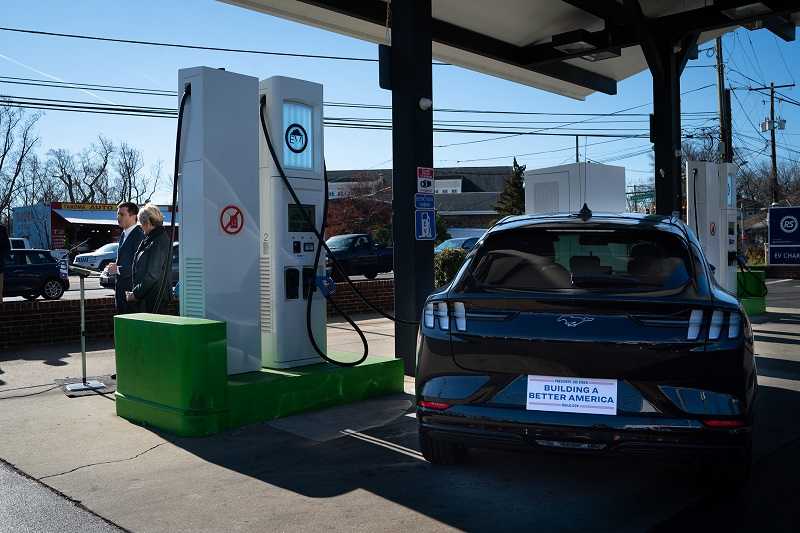
Energy Secretary Jennifer Granholm and Transportation Secretary Pete Buttigieg spoke at RS Automotive Inc., an EV charging station that used to be a gas station in Takoma Park, Md., last December.
13:53 JST, October 22, 2022
Hundreds of new electric vehicle charging stations will open as soon as next year along highways in the greater Washington region and nationwide as part of a multibillion-dollar plan to deploy fast-charging systems for a growing fleet of electric cars.
The District of Columbia, Maryland and Virginia are launching plans to add fast-charging ports along major corridors, including interstates 95, 66, 270 and 295, using $186 million allocated to the region in federal infrastructure money.
Federal officials recently gave the green light to plans submitted by each state, the District and Puerto Rico, announcing funding allocations from a $5 billion pot of money over five years. The investment comes as the Biden administration pushes to build a more convenient and affordable network of charging stations on the U.S. highway system, part of a broader push to promote climate goals.
In the Washington region, electric vehicles are a fraction of cars on the road – about 2 percent of the more than 13 million registered vehicles in D.C., Maryland and Virginia – although the number of EVs registered in the region has risen about 65-fold in the past decade.
“America led the original automotive revolution in the last century, and today . . . we’re poised to lead in the 21st century with electric vehicles,” Transportation Secretary Pete Buttigieg said in announcing the money.
The program aims to create a system in which EV charging ports are available every 50 miles along interstates, and within a mile of the highway. Each station would have at least four fast chargers that can recharge an EV battery in 15 to 45 minutes. Charging stations are currently dominated by slower chargers that can take well over an hour to charge a battery.
Transportation experts say creating such a network would reduce range anxiety among vehicle owners, one of the biggest barriers to transitioning to EVs. The federal grants will cover up to 80 percent of the costs of new charging stations, upgrades to existing stations and other expenses associated with the infrastructure. State transportation agencies will determine their locations, then hire contractors for construction and operations.
In the District, Maryland and Virginia, plans call for chargers along 36 corridors, mainly along interstate highways. Officials in the three jurisdictions said they plan to fill in gaps along routes where some charging already is available, while additional corridors could be added in the future.
“We want to make sure that these chargers are accessible to the public, that they’re located close enough together that people are confident they can get a recharge and that when they get to one of these charging stations, they’ll be operable,” said Maryland Deputy Transportation Secretary Earl Lewis.
Officials say the investments are necessary to keep up with demand as EV technology advances. More car manufacturers are building EVs and the federal government has boosted tax incentives for buyers.
A reliable network of public charging stations is critical for meeting environmental goals set across the Washington region, transportation and planning officials said. In the D.C. area, the Metropolitan Washington Council of Governments (COG) has set a goal to cut greenhouse gas emissions in half by 2030, in large part by shifting away from internal combustion engines.
Jeffrey King, director of climate, energy and air programs at COG, said the regional council recently approved a working group to provide coordination as different jurisdictions seek federal funds and deploy EV infrastructure. He said more fast-charging options will be a major incentive in the transition to EVs, although he said parts of the region will likely face challenges in finding sites, particularly in the District and other urban areas where real estate prices are high.
“Every time I drive I see more EVs, so we know they’re here and we know there are going to be more,” he said.
In 2020, the Washington region had more than 33,000 electric-vehicle owners – or about 1.7 percent of all light-duty vehicles – while there are more than 100,000 registered EVs this year across D.C., Maryland and Virginia. The increase in ownership has driven a proliferation in charging stations in the D.C. area, from more than 300 in 2012 to more than 3,500 last year, according to COG. Most of those stations, however, do not include fast chargers.
The federal funding would expand rapid charging in high-demand corridors such as Interstate 270 in Maryland – home to the state’s Zip codes with the highest rates of EV ownership – and along interstates 66 and 95 in Virginia. Officials in both states and in D.C. say the investment will be equitable while covering rural and underserved communities. State transportation officials are looking at installations in public settings near the highways, such as park-and-ride lots, community centers and gas stations.
Construction for charging stations across the Washington area will likely begin next year.
Antoine Thompson, executive director of the Greater Washington Region Clean Cities Coalition, said more investment will be needed, particularly to ensure widespread charging is available.
“This all will help with creating a nationwide network from one coast to the other. However, it won’t get every highway in the state,” he said. “It won’t get as many underserved areas as we would like, but it will drive us in the right direction.”
Lanny Hartmann, of Columbia, Md., has been driving an electric vehicle for a decade and said he often encounters difficulties finding workable or compatible chargers. He said consumers want charging stations that are interoperable and readily available.
“It is not ‘range anxiety’ but ‘charger anxiety’ that concerns us,” said Harmann, who runs a blog on plug-in infrastructure. He said he recently tested 69 fast chargers in Maryland and found 71 percent were fully functional.
While Tesla has built a network of thousands of supercharger sites in the past decade, he said, those chargers only work with Tesla vehicles, leaving a gap for a growing fleet of other EVs.
“Drivers of electric vehicles that use a different plug need a network of chargers that are convenient and reliable,” he said. “That’s what is exciting about the national electric vehicle infrastructure plan.”
Transportation officials in the District, which is getting $16.6 million, said the program will help the city advance ambitious goals to be carbon-neutral by 2050.
“These very important federal dollars will help us keep up with the demands of a modernized transportation network where electric vehicle stations are amply available and conveniently accessible to those in all eight wards of our District,” Everett Lott, the city’s transportation chief, said in a statement.
The District has six fast-charging stations and 36 ports. Slower charging stations are more widely available, with about 250 stations and more than 650 ports citywide. About 5,200 electric vehicles are registered in the District, up from about 600 six years ago.
The city said it plans to put the stations out for bid this winter, with construction to begin in spring and with completion by the end of summer 2023. Officials said plans call for adding more routes after build-out is completed in the first five corridors. Charging stations will be privately owned, with the District Department of Transportation providing oversight.
In Maryland, transportation officials said its $63 million will allow the state to build between 50 and 70 new charging stations. That would include between 200 and 280 fast-charging ports.
“This will jump-start our fast-charging infrastructure,” Lewis said, noting that the number of stations will depend on cost. He said a station could cost between $600,000 and $1 million, depending on the location and how expensive it is to run the electric utility infrastructure.
Maryland currently has a network of 1,200 stations – and nearly 3,350 ports – of which only 16 stations meet new federal requirements of four ports with at least 150 kilowatts of power each and within easy access to the highway.
State officials say a reliable network will help Maryland reach environmental goals, such as having 300,000 zero-emission vehicles by 2025, then double that by 2030. In the past decade, Maryland has seen its EV registrations spike from fewer than 1,000 to nearly 60,000.
Plans in Maryland call for expanding charging along 23 corridors, including the Capital Beltway, I-270, I-95, I-70 and routes 1, 50 and 301 in the D.C. suburbs.
Across the Potomac, Virginia is focusing on building charging infrastructure in eight corridors that includes nearly all of its interstate highway miles.
Virginia Department of Transportation spokeswoman Marshall Herman said the state’s priority at the start of the five-year program is to install stations to fill charging gaps along those corridors, then potentially add more. The state is slated to receive about $106 million in federal funding.
A 2021 VDOT survey found that current and potential EV drivers identified difficulty finding a charging station as a primary barrier to purchasing an EV. Virginia has about 44,000 registered EVs, about 1.5 percent of light-duty vehicles in the state.
There are 1,031 public charging stations in the state, with 2,912 ports across all speeds and connector types. That includes 190 fast-charging stations, of which 17 meet the federal requirement of being within a mile of the interstate and having four fast ports.
Virginia, like other jurisdictions, will not own, operate or maintain charging stations, but will provide oversight.
As states move toward launching the program, some officials said they hope to avoid supply chain challenges as 50 states, D.C. and Puerto Rico embark on similar projects. States and communities will also be able to compete for another $2.5 billion for charging infrastructure in rural, underserved and overburdened communities.
"News Services" POPULAR ARTICLE
-

American Playwright Jeremy O. Harris Arrested in Japan on Alleged Drug Smuggling
-

Japan’s Nikkei Stock Average as JGB Yields, Yen Rise on Rate-Hike Bets
-

Japan’s Nikkei Stock Average Licks Wounds after Selloff Sparked by BOJ Hike Bets (UPDATE 1)
-

Japan’s Nikkei Stock Average Buoyed by Stable Yen; SoftBank’s Slide Caps Gains (UPDATE 1)
-

Japanese Bond Yields Zoom, Stocks Slide as Rate Hike Looms
JN ACCESS RANKING
-

Keidanren Chairman Yoshinobu Tsutsui Visits Kashiwazaki-Kariwa Nuclear Power Plant; Inspects New Emergency Safety System
-

Imports of Rare Earths from China Facing Delays, May Be Caused by Deterioration of Japan-China Relations
-

University of Tokyo Professor Discusses Japanese Economic Security in Interview Ahead of Forum
-

Tokyo Economic Security Forum to Hold Inaugural Meeting Amid Tense Global Environment
-

Japan Pulls out of Vietnam Nuclear Project, Complicating Hanoi’s Power Plans




















